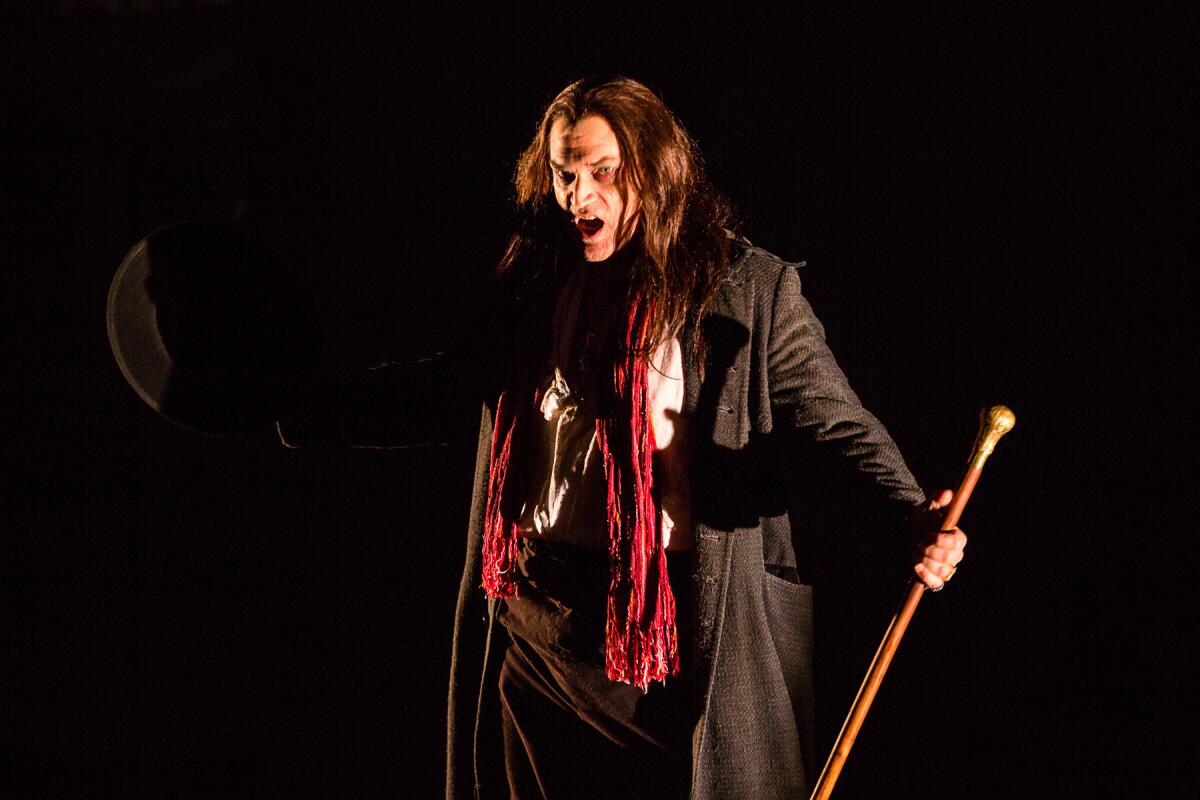Human dissection as opera: It’s the REDCAT world premiere of David Lang’s ‘Anatomy Theater’
- Share via
Less than a week after closing its main stage season with a familiar production of Puccini’s “La Bohème,” Los Angeles Opera is shifting to the smaller REDCAT for the world premiere Thursday of “Anatomy Theater,” experimental work by composer David Lang and visual artist Mark Dion.
Everything about Lang’s R-rated, experimental chamber opera stands in stark contrast to the traditional romanticism of “La Bohème.” Still, Lang had Puccini in mind when he wrote “Anatomy Theater.”
“There’s a long, spectacular history of women suffering horribly in opera,” Lang says. “We definitely were trying to place our opera in the context of that larger tradition. Our play on the trope is that no one turns out to be good in this piece. No one is completely evil, but no one is completely good. So it’s not like ‘Tosca,’ where the wrong woman dies.”

Unlike Tosca or Mimi, Sarah Osborne of “Anatomy Theater” is not an innocent victim. Just before she is hanged, she confesses to murdering her husband and two young children.
In order to re-create the feel of an 18th-century town square hanging, Osborne (Peabody Southwell) will be executed in the REDCAT gallery space adjacent to the theater. Like voyeuristic townspeople, the audience will stand and watch.
Following the execution, Joshua Crouch, the charismatic theater owner played by Marc Kudisch, will invite the audience to join him for the evening’s main event. For the remainder of the opera, the audience will observe as Osborne’s naked body is cut open and her organs exhumed and examined, one by one.
Crouch and his cohorts, an anatomist and theorist, will speak directly to the audience as they cut into Osborne’s body, eliminating any illusion of a fourth wall.

“It’s a very direct conversation with the audience,” says Kudisch during a break in rehearsals last week. “It’s very confrontational. It’s a fictional account of events that actually happened.”
The opera explores the historical phenomenon of dissection as entertainment. The men who cut into Osborne’s body are driven by a quest for scientific knowledge as well as a desire to prove the accuracy of their religious beliefs. “Where is the evil inside this woman?” they ask. “Is it in the stomach? Perhaps the spleen?”
Kudisch finds this Enlightenment-era ideology fascinating.
“We look at the science of their time and see how far we’ve come,” he says. “But listen to the science of their day and listen to their ideologies and beliefs. See what sounds archaic and see what sounds incredibly contemporary. That’s what’s important in this opera.”
It was the artist Dion who first suggested that historical public dissections of the human body might make for an interesting opera subject.
Lang was in talks with Ridge Theater in New York about creating an opera when he thought of Dion.
“Rather than make an opera with a librettist or writer, I wanted to work with someone whose work is inherently theatrical, but who probably hadn’t been invited into the world of opera yet,” Lang says.
He called Dion and asked what project he had always wanted to do, but hadn’t yet.
“Mark told me he was interested in doing a historically accurate anatomy lesson from the same period as Rembrandt’s ‘Anatomy Lesson of Dr. Nicolaes Tulp.’ I told him that, through the miracle of opera, we could actually do that and the person we anatomize can keep singing.”

If “Anatomy Theater” works, it will be a result of a modern opera A-team. Ridge Theater’s creative powerhouse — director Bob McGrath, video artist Bill Morrison and projection artist Laurie Olinder — are bringing Lang and Dion’s vision to the stage. Contemporary opera mastermind Beth Morrison of Beth Morrison Projects is responsible for bringing the piece to the L.A. Opera.
“One of the things that’s really great about opera is that it’s so collaborative,” Lang says. “Who you have in the mix, what kind of people you’re working with and what their skills, interests and talents are makes a huge difference in where you end up.”
People going to REDCAT already know they’re trying something different, Kudisch says. “You will absolutely walk out of this piece feeling very different than you did walking in. You may not necessarily be able to say you had a great time, but I guarantee you will walk out saying ‘I’ve never seen that before.’”
----------
Los Angeles Opera’s “Anatomy Theater”
Where: REDCAT, 631 W. 2nd St., Los Angeles
When: 8 p.m. Thursday-Saturday, 2 p.m. Sunday, 8 p.m. Monday
Tickets: $69
Info: (213)-972-8001, www.laopera.org
Follow The Times’ arts team @culturemonster.
The biggest entertainment stories
Get our big stories about Hollywood, film, television, music, arts, culture and more right in your inbox as soon as they publish.
You may occasionally receive promotional content from the Los Angeles Times.







